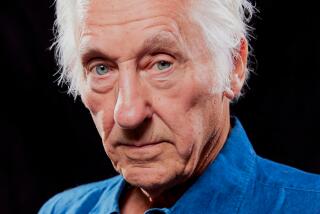Enraptured by Rauschenberg’s Art and Life : Biography: Mary Lynn Kotz’s new book is called ‘the first full-scale account’ to be done with the artist’s cooperation. It also details his quest for world peace.
- Share via
Journalist Mary Lynn Kotz recently emerged from five years of near isolation in her office near Washington with a self-granted “Ph.D in Rauschenberg.” Backing that claim is her authorship of a big, handsomely illustrated book on artist Robert Rauschenberg, who rose to prominence in the 1950s and is still going strong at age 65.
“Rauschenberg: Art and Life,” a recent Abrams publication, is being promoted as “the first full-scale account of Rauschenberg’s life and art to be written with his complete cooperation as well as the use of his archives and photographs.” The book is also the first to detail a 10-year enterprise, the Rauschenberg Overseas Culture Interchange (ROCI), which the energetic artist designed and propelled into a quest for international peace and understanding through art.
Recently in Southern California on one leg of a two-month book tour, Kotz talked about the compelling project that made her a student of Rauschenberg. “I was on assignment in 1982 for Artnews magazine at Edison Community College in Ft. Myers, Fla., where I saw the first 190 feet of Rauschenberg’s ‘ 1/4 Mile or 2 Furlong Piece.’ He intends it to be the biggest painting in the world. At last count it was 790 feet and still growing,” she said.
“I read the painting as a journalist, but the whole sweep of it was also very exciting as art. I felt what he was presenting to us was ourselves. The images portray our foibles and horrors, but also our beautiful athletes, our accomplishments and our hopes--all that is positive and all that is terrible,” she said.
Captivated by the huge, multipaneled painting, Kotz decided to write a piece on Rauschenberg for Artnews. “It took me a year to get him to agree to talk to me,” she said. The interview was scheduled in Captiva, Fla., where Rauschenberg has lived and worked for 20 years. “I got in to see him at 10 o’clock in the evening and I stayed until 3 the next morning,” she said.
With recorded conversations in hand and vivid impressions in mind, she turned out the magazine piece--and was soon invited by Abrams to expand it into a book. Access to the artist was still a problem: “He is an artaholic. His mandate is to make art” and not to talk to reporters, Kotz said. Undeterred, she set out to learn all she could about him on her own.
For four days a week during her first year of research, she worked in Rauschenberg’s archive in New York. She also traveled extensively to see his exhibitions. “He finally decided I was serious and let me into his studio so that I could watch him work,” Kotz said. As a result, she was able to present a colorful description of the artist at work and play in “Captiva,” the last chapter of the book.
Kotz, who did graduate work at the University of Iowa School of Journalism and subsequently wrote about a wide array of subjects--from life at the White House to mental health--calls her book “an appreciation” of Rauschenberg and she speaks about him in admiring tones. “As a journalist I like to write about people who are creative, particularly those like Rauschenberg who come from ordinary backgrounds but achieve extraordinary things,” she said of the kid from Port Arthur, Tex., who grew up to be one of the most celebrated artists of the 20th Century.
He and Jasper Johns emerged in 1955, when Abstract Expressionism was played out. Working with ordinary objects from popular culture, the two young artists led the way to Pop art and to later painting styles. Rauschenberg is most highly revered for his “combine paintings” of the ‘50s, which blend such unorthodox materials as a rubber tire and a stuffed goat. He has long worked in a collage-like fashion, making art that reports on society.
“I like his passion for life. I like his ideals and I like his courage,” Kotz said. The author came to see her subject as an activist with “a mission” who “wants to shake people awake” so that they are alert to world events. “He has a vision of the world, that if each of us does what we can, we can cause peace to break out,” she said.
Acting out this vision, Rauschenberg devised ROCI (pronounced Rocky and named after his pet turtle) to establish an international dialogue among artists. The project has taken him to such “sensitive” spots as China, Chile, Tibet, Cuba and the Soviet Union. He typically visits the country, makes contact with artists and writers there, collects materials and ideas, then goes home to make art. After a year or so, he returns, stages an exhibition and leaves an artwork as a gift to the host country. The show has grown at each venue as Rauschenberg adds artworks inspired by his travels.
“He really believes art is the backbone of culture” and that artists can be catalysts for change, Kotz said. But ROCI didn’t attract nearly as much financial support as Rauschenberg had hoped. He has funded most of the project himself, spending about $12 million of his own money, she said.
Largely because of high costs and complicated logistics, he will bring the project to a close with an exhibition, “Rauschenberg Overseas Culture Interchange,” at the National Gallery of Art in Washington, May 12-Sept. 2, 1991. Kotz plans to be there.
More to Read
Sign up for our Book Club newsletter
Get the latest news, events and more from the Los Angeles Times Book Club, and help us get L.A. reading and talking.
You may occasionally receive promotional content from the Los Angeles Times.






